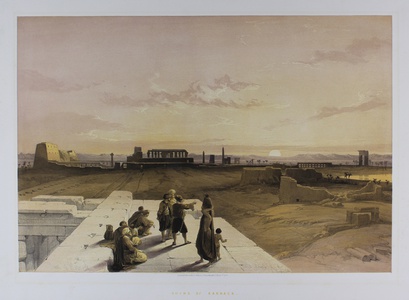| Method | Lithograph with hand colouring |
| Artist | Louis Haghe after David Roberts |
| Published | London, Published by F.G. Moon, 29 Threadneedle St., March 8th. 1847. |
| Dimensions | Image 352 x 510 mm, Sheet 445 x 610 mm |
| Notes |
A general view of the Temple Precinct of Amun Ra, in the city of Karnak, Egypt. The Karnak temple complex is one of the largest ancient religious sites in the world, comprising the Precincts of the gods Amun-Ra, Montu, and Mut, as well as a now dismantled temple of Amenhotep IV, better known as Akhenaten. The most substantial of these precincts is the Temple Complex of Amun-Ra, the state god of Egypt, and the principle deity of the Theban Triad. The complex is also one of the longest continually used religious sites in Egyptian history, having been founded during the Middle Kingdom, but added to and expanded continuously into the Roman era. Roberts' view is taken from the top of one of the colonnades of the temple complex. In the immediate foreground are a group of men in Arab dress, as well as a woman carrying a large water jug on her head accompanied by a small naked child. The pylons, portico, and obelisks of the Temple of Amun Ra can be seen on the horizon, along with the palm-lined banks of the Nile. David Roberts RA (24 October 1796 – 25 November 1864) David Roberts' monumental works on the Middle East: The Holy Land and Egypt & Nubia, is considered the greatest lithographically illustrated works issued in the 19th century. Roberts' masterpiece was issued in 41 parts over seven years in three states; tinted, tinted proof and coloured and mounted on card. The prints were masterfully lithographed by Louis Haghe, to whom Roberts paid tribute in glowing terms, `Haghe has not only surpassed himself, but all that has hitherto been done of a similar nature. He has rendered the views in a style clear, simple and unlabored, with a masterly vigor and boldness which none but a painter like him could have transferred to stone'. Abbey regarded the work as `one of the most important and elaborate ventures of nineteenth-century publishing, and the apotheosis of the tinted lithograph'. David Roberts was born in Stockbridge near Edinburgh, and at the early age of 10 apprenticed to Gavin Buego, a house painter. He continued to work for Buego after his apprenticeship had been completed, carrying out work on imitation stonework and panelling at Scone Palace and Abercairney Abbey. By 1818 Roberts had become assistant scene painter at the Pantheon theatre in Edinburgh, moving on to work in theatres in Glasgow and finally in late 1821 to Drury Lane theatre in London, where he worked with Clarkson Stanfield. Both artists exhibited at the Society of British Artists, Royal Academy and British Institution, and by 1830 Roberts was firmly established as a topographical artist and was able to give up his theatre work. In these early years he toured the continent and Scotland, and in 1832-33 visited Spain. In 1838 he made plans for his journey to the Near East, inspired by a love of artistic adventure; departing in August 1839 for Alexandria, he spent the remaining part of the year in Cairo, visiting the numerous tombs and sites. In February of the following year he set out to cross the desert for the Holy Land by way of Suez, Mount Sinai and Petra arriving in Gaza, and then on to Jerusalem, concluding his tour spending several months visiting the biblical sites of the Holy Land, and finally returning to England at the end of 1839. The drawings of his tour were submitted to F.G. Moon in 1840 who arranged to bring out a work illustrative of Scripture History, paying Roberts £ 3,000 for the copyright of the sketches, and for his labour in supervising Louis Haghe's lithography. Both the exhibition of his original watercolours and the subsequent published work were an immediate success and confirmed his reputation as an architectural and landscape artist of the highest order. Louis Haghe (1806-1885) was part of the firm of Day & Haghe, which was one of the most prominent lithographic companies of the nineteenth-century. They were also amongst the foremost pioneers in the evolution of chromolithography. The firm was established in 1823 by William Day, but did not trade under the moniker of Day & Haghe until the arrival of Louis Haghe in 1831. In 1838, Day & Haghe were appointed as Lithographers to the Queen. However, and perhaps owing to the fact that there was never a formal partnership between the two, Haghe left the firm in the 1850's to devote himself to watercolour painting. The firm continued as Day & Son under the guidance of William Day the younger (1823 - 1906) but, as a result of a scandal involving Lajos Kossuth, was forced into liquidation in 1867. Vincent Brookes bought the company in the same year, and would produce the caricatures for Gibson Bowles' Vanity Fair magazine, as well as the illustrations for Cassell's Poultry Book, amongst other commissions. Condition: Toning from previous mount, foxing to sheet edge. |
| Framing | unmounted |
| Price | £850.00 |
| Stock ID | 49004 |

